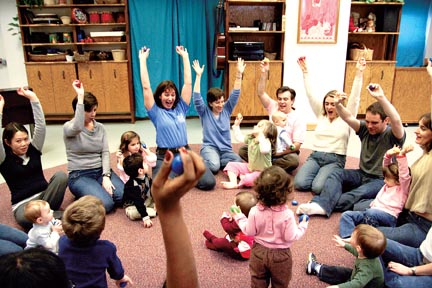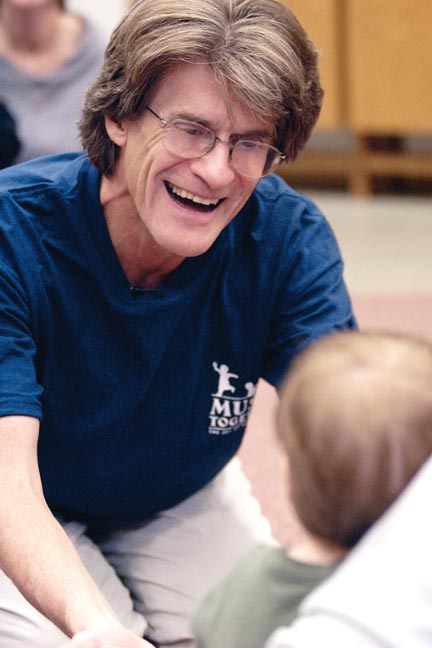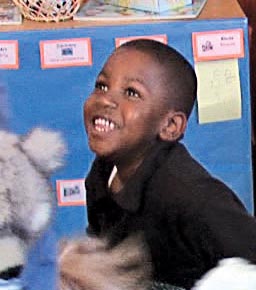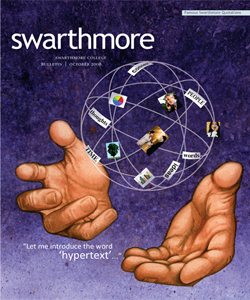Making Music Together Again
Guilmartin considers music to be every child’s birthright. “Tone deaf does not really exist,” he says. “It’s just a matter of education.”
As a boy, Kenneth Guilmartin ’67 couldn’t carry a tune in a bucket. His kindergarten teacher labeled him a “crow” and asked him to mouth the words instead of singing with the other children. It was only in his 20s that he learned to sing, taking remedial voice lessons to keep pace with his burgeoning musical career.
Today, kids from China to Croatia are singing Guilmartin’s tunes. He is the founder and director of Music Together ®, an innovative, research-based music program for children from birth to age six. Launched in 1987, Music Together has blossomed into a global phenomenon in the toddler and preschool world. You can find Music Together classes in 2,000 communities worldwide, including nearly all 50 states and 26 foreign countries.
Guilmartin considers music to be every child’s birthright. “Tone deaf does not really exist,” he says. “It’s just a matter of education.” Children are wired to absorb their native music as easily as they master their native language. But this natural musical ability fades if it’s not nourished. By age 9, an individual’s level of inborn musical aptitude becomes permanent in the human brain. Children can become more skillful at music, but the foundation is set for life. For those (like Guilmartin) who missed this critical window, it’s a struggle to catch up. What children need, he says, is music immersion in their daily lives.
Today’s media culture is awash in music. But recorded music doesn’t fit the bill, according to Guilmartin. Evoking an ideal picture of Grandma singing in the kitchen, he says children learn music best by hearing their parents and loved ones singing. “Music is seen as a culture of talent,” he says. “We passively consume music as grown-ups instead of making it.”
That attitude is filtering down to children in the United States and increasingly worldwide as families download songs and rely on professional performers to provide music. Fewer adults are able to clap to the beat or sing in tune. Through studies done at his research branch, the Center for Music and Young Children, Guilmartin finds American children to be lagging behind their musical potential. “Most children in our culture are developmentally delayed by two to five years in music,” he says. “It’s a case of simple neglect.”
Music Together aims to reverse that trend. The first to admit he might be a “wounded healer,” Guilmartin devotes his life to giving children a good musical start. To do that, he and Lili Levinowitz, a professor of music education at Rowan University, co-created a playful program designed to help children gain “basic music competence”—singing in tune and keeping a beat. It also strives to put daily family music-making back in the home and give parents the tools to do it. Music Together embraces the whole family, inviting grandparents and siblings of mixed ages to class, with a special welcome for babies.
“All of us are born with a personal pitch center,” says Guilmartin. Babies tend to cry, coo, and babble around an individual tone. If you find an infant’s natural pitch, she is more likely to respond or be soothed by a lullaby in that key. Soon, babies change their pitch to match a song, cooing back in the resting tone or the fifth, the dominant note.
“They’re in the game from the beginning,” says Leigh Mamlin, a registered Music Together teacher and director of Music Matters in Columbus, Ohio. “There’s nothing more mood stabilizing for babies than their parent’s voice singing to them.”
Mamlin discovered Music Together as a parent. She immediately liked its emphasis on play and its understanding of child development. At Music Together classes, adults are asked to participate in all the songs and actions, but kids don’t have to. Children can walk, run, dance, put maracas in their mouths, or silently observe. Mamlin’s son, Charlie, then 2, spent entire classes falling down in front of a mirror. “I did have that feeling, ‘Oh, my gosh, what am I paying for here?’ But then we’d come home, and he would be chanting the songs and know the movements,” she says.
Nonstop movement and giggles set the tone at Georgia O’Brien’s Music Together class in Traverse City, Mich. After a welcome song, “Hello Everybody, so glad to see you …, ” she launches into “My ball is big and blue; I’m rolling it right to you….” One song slides seamlessly into the next. Silliness rules. Georgia taps rhythm sticks on the floor to a wordless “bum bum” tune, then waggles them on her head like antenna, singing “bzz bzz buzz.” When she dumps out an enormous basket of instruments, the kids leap up as if it’s candy. Tanner, a jowly-cheeked toddler, beats a tambourine. Jacob, 5, clanks a “clatterpiller.” Moms and dads join in, striking triangles and clapping frog-shaped castanets.
Whether it’s ball-rolling, finger plays, or dancing, movement is part of each song. That’s partly due to Guilmartin’s background in Dalcroze Eurhythmics. Emile Jaques-Dalcroze, a Swiss music educator, believed children learn music best through playful movement.
As children grow musically, they learn to audiate—to hear music internally. Leaving out a note in a familiar song like “Twinkle, Twinkle, Little Star,” for example, demonstrates how the brain can hear the next note before it arrives. Music Together believes that audiation is the key to music-making, and singing is the path to develop it. “Kids learn best from the unaccompanied human voice,” says Mamlin.
Many families introduce music by starting with piano lessons. Big mistake, says Guilmartin. If children haven’t yet grasped rhythm and pitch, instrument lessons are likely to frustrate teacher, child, and parents alike. “These are your lessons, you have to practice 30 minutes every day—that can be negative for a child,” agrees Mamlin. “As long as your family’s musical diet is diverse and joyful and constant, you are doing no harm to wait.”
A hallmark of Music Together is its meticulously researched song collections, which offer a rich musical diet. Sporting titles like “Bongos,” “Maracas,” and “Tambourine,” each 10-week collection exposes families to a range of music from around the world, including songs in minor keys, asymmetric meters, and songs without words. “Words can really trip kids up on songs,” says Mamlin. Music Together offers plenty of songs using vocables such as “doo doo doo” or “la la la.” These help children focus on pitch without the distraction of lyrics. Likewise, rhythmic chants help them hear the beat, and props like balls help them feel it. “It’s taking the pulse of the song and putting it into a big movement,” says Mamlin. Other songs include dog howls, sirens, or whoops that help lift voices out of the talking voice and into the upper register. Guilmartin and Levinowitz also pitch songs in a natural singing range for children (the A below middle-C to the D an octave higher) unlike most children’s music, which is pitched higher.
Guilmartin likes to borrow from Spanish and Hasidic Jewish traditions for dancing. “The driving energy inspires kids to spin, leap, and dance. It’s rhythmic, active, and a touch wild,” he says. He and Levinowitz mix in jazz, blues, and folk, plus music from many cultures including Irish, Greek, and Chinese heritage. “World music is everybody’s music now,” says Guilmartin. They make sure to include at least one Spanish-language song each time to honor the cultures of the Americas. Global music exposes kids to a variety of rhythms and pitches. For example, traditional Greek dances tap out in five beats to the measure, instead of three or four. “Asymmetric meter is not hard for a baby or a 3-year-old. It’s easier for them,” says Guilmartin. “We’re locked into what we grew up with.”
 As Guilmartin concocts song collections, he makes sure to slip in “musical vitamins.” These include several minor key modes like Aeolian, Dorian, and Phrygian. “Look at the back of a bottle of multivitamins,” he says. “It’s got all these words you can’t pronounce. Well, that’s the Aeolian, Dorian, and Phrygian. It’s in there. It’s not children’s music.” Music Together also includes a hearty dose of minor keys. “To give children just what you think is children’s music, people make the mistake of doing easy songs in major keys—happy songs,” says Guilmartin. “A lot of them are pretty boring.”
As Guilmartin concocts song collections, he makes sure to slip in “musical vitamins.” These include several minor key modes like Aeolian, Dorian, and Phrygian. “Look at the back of a bottle of multivitamins,” he says. “It’s got all these words you can’t pronounce. Well, that’s the Aeolian, Dorian, and Phrygian. It’s in there. It’s not children’s music.” Music Together also includes a hearty dose of minor keys. “To give children just what you think is children’s music, people make the mistake of doing easy songs in major keys—happy songs,” says Guilmartin. “A lot of them are pretty boring.”
Most children’s music tends to grate on adult nerves—think Barney, the singing purple dinosaur on television. But Music Together songs draw adults in. “At first, we argued over who would take him to class,” says Mia Nitchun-Sacks, mother of 14-month-old Reed in Princeton, N.J. “Finally, we agreed we would both take him. It became the highlight of the week.” Not only was the class fun, but they brought the music home. Her husband, Jeff, started playing music with Reed in the evenings. “Now they go through the songbook and play instruments together. It totally transformed their relationship.”
This is music to Guilmartin’s ears. Besides the careful mix of meters and musical vitamins, Music Together wants to rekindle the joy of singing at home. If adults like the music, they will sing around the house the way families did before recorded music. “For eons, humans have made music together as part of daily life,” he says. “[Adults] need to set the model of being music-makers.” He laments the loss of music in schools, too, remembering the day when kindergarten teachers had to be able to play piano in order to get a teaching job. “There are still a lot of pianos in a lot of kindergarten rooms, but they’re out of tune, and almost nobody uses them,” he says.
These days, Guilmartin is adapting the Music Together format for preschools and daycare centers, including Head Start. He says U.S. schools approach music education backwards—neglecting it in early years, then creating school orchestras in fifth grade. Trained Music Together teachers lead school sessions, but Guilmartin says children need to hear their classroom teachers singing, too. “It’s not musical babysitting. [Teachers] are also primary caregivers, and their model is just as powerful.”
Even for the lucky child raised in a musical household, Music Together classes have a place. “There is absolutely no substitute for the social aspect of Music Together,” says Mamlin. “People leave my class with smiles on their faces. It’s an absolutely joyful experience to make music with other people.”
Or, as Guilmartin would say, let’s make music together again.
 Email This Page
Email This Page


December 2nd, 2008 3:44 pm
Any Music Together groups in New Hampshire - especially Hanover or Concord or Laconia areas?
December 2nd, 2008 4:07 pm
There's a class locator at http://www.musictogether.com/ClassLocator.aspx
June 21st, 2010 1:25 pm
AWESOME…as the new grandmother of twins I would love to get a hold of a cd if it is available. This article brought tears to my eyes & I thank you.
Fern
July 15th, 2010 8:56 am
Fern,
Enjoy singing with those two precious grandchildren! If you attend a Music Together class in your area, you receive a CD with enrollment. The Music Together home office also offers some compilation "family favorite" CDs for sell through their website: http://store.musictogether.com/music-together-cds.php
Thanks for writing.